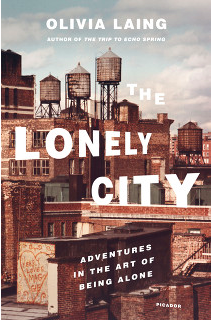The Lonely City
Every now and then I read a book that so wholly absorbs me I want to share it with everyone with whom I think it might connect. The Lonely City by Olivia Laing is one of those books. Part memoir, part art history, and part criticism, The Lonely City chronicles Laing’s experience living in New York after moving there from London to live with a lover who subsequently abandons her. A writer and critic, Laing trains her lens on the art that moved her most deeply, the paintings, photographs, videos and stories that comforted and pricked during her lonely stint in New York.
“Almost the only thing I found consoling was watching music videos on YouTube, curled on the sofa with my headphones on, listening again and again to the same voices finding the register for their distress . . . It was during this period that I first came across Klaus Nomi, mutant chantant, who made an art of being an alien, like no one else on earth . . . The film I liked best was of his very first appearance, at Irving Plaza on 15th Street in 1978, performing at a night called New Wave Vaudeville. He appears on stage in a see-through plastic cape, with wings painted around his eyes. A science-fiction figure, gender indeterminate, he opens his mouth and out comes ‘Mon cœur s’ouvre à ta voix’, my heart opens to your voice.”
Dishy and deeply researched, Laing opens each chapter with a personal anecdote that blossoms into an essay about a particular artist’s work, explaining how and why she connected with it, and making it newly relevant to contemporary viewers awash in digital culture.
“Warhol is often thought of as being completely subsumed by the glossy carapace of his own celebrity, of having successfully transformed himself into an instantly recognizable avatar . . . But one of the interesting things about his work, once you stop to look, is the way the real, vulnerable, human self remains stubbornly visible, exerting its own submerged pressure, its own mute appeal to the viewer.”
If ever a book called out for hypertext, it’s this one. Containing just a few images, mainly photographed portraits of the artists she writes about: Edward Hopper, Andy Warhol, David Wojnarowicz, Henry Darger, Klaus Nomi, and a still from a documentary about Josh Harris’ project, We Live in Public, each chapter bubbles with alluring descriptions of visual art, the people who made it and their happenings.
By blending anecdotes with insights and thoughtful writing about art, The Lonely City challenges the creepy paradox of the internet, the way it simultaneously isolates and connects, in a way that feels personal rather than analytical. While Laing cites several other excellent, recent books about how devices are changing culture, like Alone Together by Sherry Turkle and The Shallows by Nicholas Carr, The Lonely City doesn’t follow their lead. It’s not a warning bolstered by cognitive science. Nor does it offer advice. But rather the author offers her vulnerability, her experience feeling lonely in a connected-all-the-time culture, as a gift to the reader in a fascinating read that places art and people rather than science and data at its center.

Just bought it to take with me on my trip today. Thanks for your timeliness!
Yay! I can’t wait to hear what you think about it, Alyson.